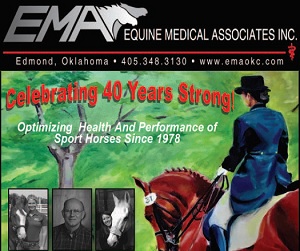Whether you’re a casual trail rider or the competitive type, you’ve probably heard some doozies when it comes to horse myths and lore. But which ones are true? What isn’t true? We turned to our resident expert, Dr. Kris Hiney, to spread some light on common horse myths that circulate among the industry. Here are her top five horse myths debunked.
By Dr. Kris Hiney
- Horses can’t see color.
False. While older textbooks that still exist will say that horses (or all animals for that matter) don’t see color, we now know this isn’t true. Several studies have documented that horses do indeed see color, just a bit differently than we do. Humans have trichromatic vision, which means we see reds, blues and greens, while horses have dichromatic vision or see in blues and greens. The difference in vision is due to the type of cones in the eyes—which are the cells that detect photopigment.
Essentially, a horse’s version of the world is a bit more muted in color than ours, more of a yellow/olive/bluish tone. This may mean that brown things look similar to green things in a horse’s world. Wonder how they test equine vision? Researchers train horses to perform a color vision test similar to that of children prior to the development of language skills. The test horses were trained to independently perform a chain of behaviors to prevent the horse from picking up any inadvertent cues from human handlers. The horses were trained to stand in a waiting station marked by cones and remain behind a horizontal PVC bar until the test was ready to begin. The horses then had to perform a discrimination test to assess their vision.
Two color plates would appear from behind sliding plates, and the horse would approach and hold its nose at the correct plate until receiving a reward or hearing “no” (a non-reinforcement marker for those in the dog training world). After either receiving the reward or hearing no, the horses would return back to the waiting station until the next trial. What clever test subjects! The horses learned to pick the slide where they could see a circle in the background color. The test did confirm that horses are red green color deficient.
Are there practical implications for color vision in horses? Dichromats, like horses, are able to see better in low light, which is more useful for them to navigate often-rough terrain at all times. While horses have been jumping green jumps in brown dirt arenas for a very long time, in 2014, researchers found horses to be more likely to make errors jumping blue versus green jumps while performing in an indoor arena. These differences disappeared in the outdoor turf arena. Most likely, they use other visual cues (hue, brightness, depth) to traverse their world with ease.
And while we are on the subject of vision, objects horses have seen with one eye (or on one side of their body) are recognized with the other eye.
- Hot- and cold-blooded horses have a difference in body temperature.
While it might be fun to imagine wide swings in body temperature between types of horses, it just isn’t true. Hot- and cold-blooded horses run the same temperature—good old average 100.5 Fahrenheit. “Hot- and cold-blooded” instead refers to the type or breeding of the horses, but these terms do have some correlations to environmental temperatures.
Cold-blooded horses have a heavier, more compact body morphology, which is more efficient at retaining heat in colder climates. Think draft horses—Shires, Clydesdales, Belgians. By comparison, the hot-blooded horses have a more slender physique that is geared toward greater heat dissipation through finer skin, larger nostrils, etc. Arabians and Thoroughbreds easily fall into this group.
Hot-blooded horses are typically thought of as more reactive or “hotter” horses while cold blooded horses are usually much calmer and laid back. Hot-blooded horses run metabolically a bit “hotter,” often being much harder keepers than their efficient cold-blooded cousins.
While not different in body temperature, researchers have attempted to standardize “normal” hematological values for different breeds or types of horses including Barbs, primitive breeds, hot or light horse breeds, and cold-blooded or draft type horses. The hot horses have higher red blood cell counts, hemoglobin, packed cell volume and total blood volume compared to the gentle giants. Hot-blooded horses even have higher white blood cells than cold-blooded horses, but temperature remains the same. In both types of horses, elevated temperatures are due to exercise, illness or heat stress, and it is important to always learn normal for “your” horse.
- Horses only sleep standing up.
Well, that one is just plain wrong. While many non-horse people have assumed a horse lying flat out is dead—and called the authorities—unless he is still there 24 hours later, he is more likely just enjoying a snooze in the sunshine.
Horses do have the unique ability to sleep standing up due to their passive stay apparatus (the inter-workings of muscles, ligaments and tendons that lock into place when muscles relax), but they also like to take a relaxing siesta on the ground. Typically, you may see a bunch of horses snoozing away while one horse remains standing—just to keep an eye on things.
Sleeping lying down is actually essential for horse health. Horses need to lie down to completely enter into REM sleep. Young horses, especially, spend more time sacked out as their bodies grow. Horses are more likely to sleep lying flat out or propped onto their chests when they are comfortable. The surface is comfortable, they feel relaxed, and they can easily get up and down. Environments or conditions where horses cannot lie down, such as pain, arthritis, too small of stalls, changes in lighting and poor weather, can lead to sleep deprivation. Owners should be concerned if they never see their horse sleeping on the ground. Sleep aids, such as pain management, melatonin or other mood-altering drugs, may even be necessary to allow normal sleep patterns.
- You should never walk or stand behind a horse.
Well, that is just impossible; some days you are going to have to walk behind a horse. The origin of this advice—and it is good advice for novice horse handlers and children—is due to the horse’s inability to see directly behind him if he is looking straight ahead. A startled horse can react swiftly with deadly force. The horse has an ability to see almost all the way around him due to his monocular vision, or ability to see separately with each eye, and with eye placement on the sides of the head. Most prey species of animals have monocular vision to detect predators that may be advancing upon them.
The common advice for walking behind a horse is to stay tucked in close to his body so that any chance kick does not have as great of a damaging effect, or take a path wider than the range of his hind feet. The other suggestion is to always make sure the horse knows you are there through touch or voice. The last thing you want to do is startle a horse who is either paying attention solely ahead of him or may be dozing off.
5. You should never let a colicking horse lie down.
The origins of this myth may be in the prevention of a horse twisting its gut or injuring itself while rolling violently. However, if your horse is rolling violently, it is likely because the gut has already twisted, not because of rolling. Walking a horse may also help stimulate bowel movement but may only help with a slight impaction. If a horse is not rolling repeatedly or violently, it may be better to just allow the horse to rest.
Remove any feed in order to not exaggerate an impaction and monitor the horse until the veterinarian arrives. If possible, place the horse in a small pen or paddock to prevent injuries if rolling excessively. Certainly, never place yourself in harm’s way, but fighting to keep a horse walking will just exhaust both of you.

